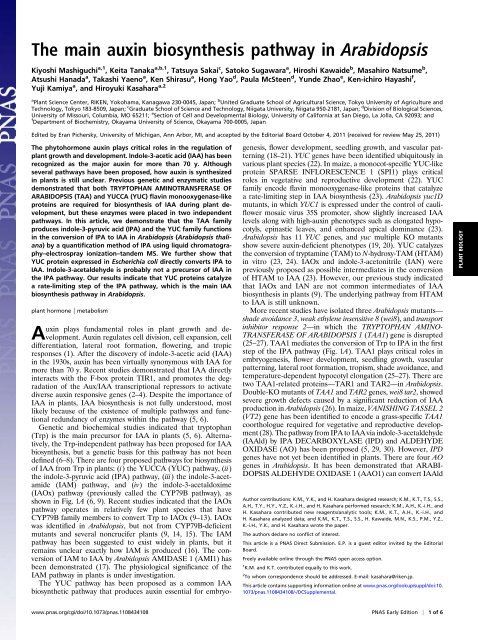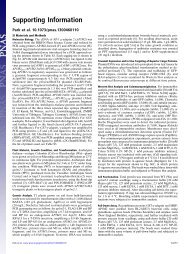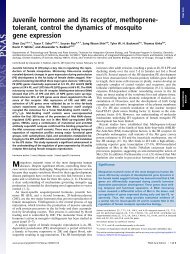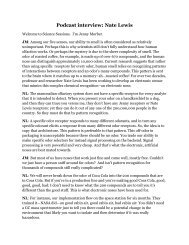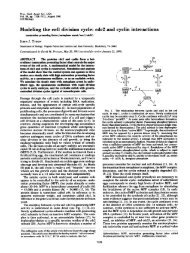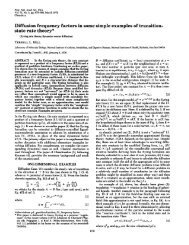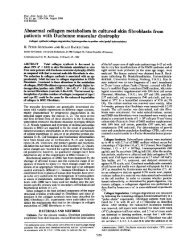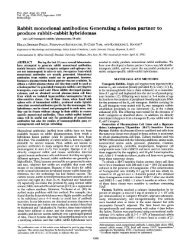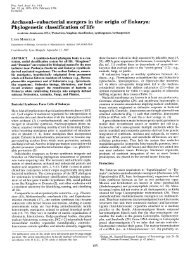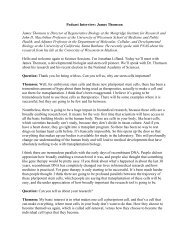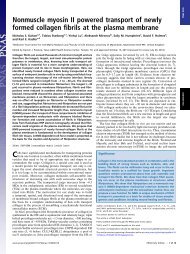The main auxin biosynthesis pathway in Arabidopsis
The main auxin biosynthesis pathway in Arabidopsis
The main auxin biosynthesis pathway in Arabidopsis
Create successful ePaper yourself
Turn your PDF publications into a flip-book with our unique Google optimized e-Paper software.
<strong>The</strong> <strong>ma<strong>in</strong></strong> <strong>aux<strong>in</strong></strong> <strong>biosynthesis</strong> <strong>pathway</strong> <strong>in</strong> <strong>Arabidopsis</strong><br />
Kiyoshi Mashiguchi a,1 , Keita Tanaka a,b,1 , Tatsuya Sakai c , Satoko Sugawara a , Hiroshi Kawaide b , Masahiro Natsume b ,<br />
Atsushi Hanada a , Takashi Yaeno a , Ken Shirasu a , Hong Yao d , Paula McSteen d , Yunde Zhao e , Ken-ichiro Hayashi f ,<br />
Yuji Kamiya a , and Hiroyuki Kasahara a,2<br />
a Plant Science Center, RIKEN, Yokohama, Kanagawa 230-0045, Japan; b United Graduate School of Agricultural Science, Tokyo University of Agriculture and<br />
Technology, Tokyo 183-8509, Japan; c Graduate School of Science and Technology, Niigata University, Niigata 950-2181, Japan; d Division of Biological Sciences,<br />
University of Missouri, Columbia, MO 65211; e Section of Cell and Developmental Biology, University of California at San Diego, La Jolla, CA 92093; and<br />
f Department of Biochemistry, Okayama University of Science, Okayama 700-0005, Japan<br />
Edited by Eran Pichersky, University of Michigan, Ann Arbor, MI, and accepted by the Editorial Board October 4, 2011 (received for review May 25, 2011)<br />
<strong>The</strong> phytohormone <strong>aux<strong>in</strong></strong> plays critical roles <strong>in</strong> the regulation of<br />
plant growth and development. Indole-3-acetic acid (IAA) has been<br />
recognized as the major <strong>aux<strong>in</strong></strong> for more than 70 y. Although<br />
several <strong>pathway</strong>s have been proposed, how <strong>aux<strong>in</strong></strong> is synthesized<br />
<strong>in</strong> plants is still unclear. Previous genetic and enzymatic studies<br />
demonstrated that both TRYPTOPHAN AMINOTRANSFERASE OF<br />
ARABIDOPSIS (TAA) and YUCCA (YUC) flav<strong>in</strong> monooxygenase-like<br />
prote<strong>in</strong>s are required for <strong>biosynthesis</strong> of IAA dur<strong>in</strong>g plant development,<br />
but these enzymes were placed <strong>in</strong> two <strong>in</strong>dependent<br />
<strong>pathway</strong>s. In this article, we demonstrate that the TAA family<br />
produces <strong>in</strong>dole-3-pyruvic acid (IPA) and the YUC family functions<br />
<strong>in</strong> the conversion of IPA to IAA <strong>in</strong> <strong>Arabidopsis</strong> (<strong>Arabidopsis</strong> thaliana)<br />
by a quantification method of IPA us<strong>in</strong>g liquid chromatography–electrospray<br />
ionization–tandem MS. We further show that<br />
YUC prote<strong>in</strong> expressed <strong>in</strong> Escherichia coli directly converts IPA to<br />
IAA. Indole-3-acetaldehyde is probably not a precursor of IAA <strong>in</strong><br />
the IPA <strong>pathway</strong>. Our results <strong>in</strong>dicate that YUC prote<strong>in</strong>s catalyze<br />
a rate-limit<strong>in</strong>g step of the IPA <strong>pathway</strong>, which is the <strong>ma<strong>in</strong></strong> IAA<br />
<strong>biosynthesis</strong> <strong>pathway</strong> <strong>in</strong> <strong>Arabidopsis</strong>.<br />
plant hormone | metabolism<br />
Aux<strong>in</strong> plays fundamental roles <strong>in</strong> plant growth and development.<br />
Aux<strong>in</strong> regulates cell division, cell expansion, cell<br />
differentiation, lateral root formation, flower<strong>in</strong>g, and tropic<br />
responses (1). After the discovery of <strong>in</strong>dole-3-acetic acid (IAA)<br />
<strong>in</strong> the 1930s, <strong>aux<strong>in</strong></strong> has been virtually synonymous with IAA for<br />
more than 70 y. Recent studies demonstrated that IAA directly<br />
<strong>in</strong>teracts with the F-box prote<strong>in</strong> TIR1, and promotes the degradation<br />
of the Aux/IAA transcriptional repressors to activate<br />
diverse <strong>aux<strong>in</strong></strong> responsive genes (2–4). Despite the importance of<br />
IAA <strong>in</strong> plants, IAA <strong>biosynthesis</strong> is not fully understood, most<br />
likely because of the existence of multiple <strong>pathway</strong>s and functional<br />
redundancy of enzymes with<strong>in</strong> the <strong>pathway</strong> (5, 6).<br />
Genetic and biochemical studies <strong>in</strong>dicated that tryptophan<br />
(Trp) is the <strong>ma<strong>in</strong></strong> precursor for IAA <strong>in</strong> plants (5, 6). Alternatively,<br />
the Trp-<strong>in</strong>dependent <strong>pathway</strong> has been proposed for IAA<br />
<strong>biosynthesis</strong>, but a genetic basis for this <strong>pathway</strong> has not been<br />
def<strong>in</strong>ed (6–8). <strong>The</strong>re are four proposed <strong>pathway</strong>s for <strong>biosynthesis</strong><br />
of IAA from Trp <strong>in</strong> plants: (i) the YUCCA (YUC) <strong>pathway</strong>, (ii)<br />
the <strong>in</strong>dole-3-pyruvic acid (IPA) <strong>pathway</strong>, (iii) the <strong>in</strong>dole-3-acetamide<br />
(IAM) <strong>pathway</strong>, and (iv) the <strong>in</strong>dole-3-acetaldoxime<br />
(IAOx) <strong>pathway</strong> (previously called the CYP79B <strong>pathway</strong>), as<br />
shown <strong>in</strong> Fig. 1A (6, 9). Recent studies <strong>in</strong>dicated that the IAOx<br />
<strong>pathway</strong> operates <strong>in</strong> relatively few plant species that have<br />
CYP79B family members to convert Trp to IAOx (9–13). IAOx<br />
was identified <strong>in</strong> <strong>Arabidopsis</strong>, but not from CYP79B-deficient<br />
mutants and several noncrucifer plants (9, 14, 15). <strong>The</strong> IAM<br />
<strong>pathway</strong> has been suggested to exist widely <strong>in</strong> plants, but it<br />
re<strong>ma<strong>in</strong></strong>s unclear exactly how IAM is produced (16). <strong>The</strong> conversion<br />
of IAM to IAA by <strong>Arabidopsis</strong> AMIDASE 1 (AMI1) has<br />
been demonstrated (17). <strong>The</strong> physiological significance of the<br />
IAM <strong>pathway</strong> <strong>in</strong> plants is under <strong>in</strong>vestigation.<br />
<strong>The</strong> YUC <strong>pathway</strong> has been proposed as a common IAA<br />
biosynthetic <strong>pathway</strong> that produces <strong>aux<strong>in</strong></strong> essential for embryo-<br />
genesis, flower development, seedl<strong>in</strong>g growth, and vascular pattern<strong>in</strong>g<br />
(18–21). YUC genes have been identified ubiquitously <strong>in</strong><br />
various plant species (22). In maize, a monocot-specific YUC-like<br />
prote<strong>in</strong> SPARSE INFLORESCENCE 1 (SPI1) plays critical<br />
roles <strong>in</strong> vegetative and reproductive development (22). YUC<br />
family encode flav<strong>in</strong> monooxygenase-like prote<strong>in</strong>s that catalyze<br />
a rate-limit<strong>in</strong>g step <strong>in</strong> IAA <strong>biosynthesis</strong> (23). <strong>Arabidopsis</strong> yuc1D<br />
mutants, <strong>in</strong> which YUC1 is expressed under the control of cauliflower<br />
mosaic virus 35S promoter, show slightly <strong>in</strong>creased IAA<br />
levels along with high-<strong>aux<strong>in</strong></strong> phenotypes such as elongated hypocotyls,<br />
ep<strong>in</strong>astic leaves, and enhanced apical dom<strong>in</strong>ance (23).<br />
<strong>Arabidopsis</strong> has 11 YUC genes, and yuc multiple KO mutants<br />
show severe <strong>aux<strong>in</strong></strong>-deficient phenotypes (19, 20). YUC catalyzes<br />
the conversion of tryptam<strong>in</strong>e (TAM) to N-hydroxy-TAM (HTAM)<br />
<strong>in</strong> vitro (23, 24). IAOx and <strong>in</strong>dole-3-acetonitrile (IAN) were<br />
previously proposed as possible <strong>in</strong>termediates <strong>in</strong> the conversion<br />
of HTAM to IAA (23). However, our previous study <strong>in</strong>dicated<br />
that IAOx and IAN are not common <strong>in</strong>termediates of IAA<br />
<strong>biosynthesis</strong> <strong>in</strong> plants (9). <strong>The</strong> underly<strong>in</strong>g <strong>pathway</strong> from HTAM<br />
to IAA is still unknown.<br />
More recent studies have isolated three <strong>Arabidopsis</strong> mutants—<br />
shade avoidance 3, weak ethylene <strong>in</strong>sensitive 8 (wei8), and transport<br />
<strong>in</strong>hibitor response 2—<strong>in</strong> which the TRYPTOPHAN AMINO-<br />
TRANSFERASE OF ARABIDOPSIS 1 (TAA1) gene is disrupted<br />
(25–27). TAA1 mediates the conversion of Trp to IPA <strong>in</strong> the first<br />
step of the IPA <strong>pathway</strong> (Fig. 1A). TAA1 plays critical roles <strong>in</strong><br />
embryogenesis, flower development, seedl<strong>in</strong>g growth, vascular<br />
pattern<strong>in</strong>g, lateral root formation, tropism, shade avoidance, and<br />
temperature-dependent hypocotyl elongation (25–27). <strong>The</strong>re are<br />
two TAA1-related prote<strong>in</strong>s—TAR1 and TAR2—<strong>in</strong> <strong>Arabidopsis</strong>.<br />
Double-KO mutants of TAA1 and TAR2 genes, wei8 tar2, showed<br />
severe growth defects caused by a significant reduction of IAA<br />
production <strong>in</strong> <strong>Arabidopsis</strong> (26). In maize, VANISHING TASSEL 2<br />
(VT2) gene has been identified to encode a grass-specific TAA1<br />
coorthologue required for vegetative and reproductive development<br />
(28). <strong>The</strong> <strong>pathway</strong> from IPA to IAA via <strong>in</strong>dole-3-acetaldehyde<br />
(IAAld) by IPA DECARBOXYLASE (IPD) and ALDEHYDE<br />
OXIDASE (AO) has been proposed (5, 29, 30). However, IPD<br />
genes have not yet been identified <strong>in</strong> plants. <strong>The</strong>re are four AO<br />
genes <strong>in</strong> <strong>Arabidopsis</strong>. It has been demonstrated that ARABI-<br />
DOPSIS ALDEHYDE OXIDASE 1 (AAO1) can convert IAAld<br />
Author contributions: K.M., Y.K., and H. Kasahara designed research; K.M., K.T., T.S., S.S.,<br />
A.H., T.Y., H.Y., Y.Z., K.-i.H., and H. Kasahara performed research; K.M., A.H., K.-i.H., and<br />
H. Kasahara contributed new reagents/analytic tools; K.M., K.T., A.H., K.-i.H., and<br />
H. Kasahara analyzed data; and K.M., K.T., T.S., S.S., H. Kawaide, M.N., K.S., P.M., Y.Z.,<br />
K.-i.H., Y.K., and H. Kasahara wrote the paper.<br />
<strong>The</strong> authors declare no conflict of <strong>in</strong>terest.<br />
This article is a PNAS Direct Submission. E.P. is a guest editor <strong>in</strong>vited by the Editorial<br />
Board.<br />
Freely available onl<strong>in</strong>e through the PNAS open access option.<br />
1<br />
K.M. and K.T. contributed equally to this work.<br />
2<br />
To whom correspondence should be addressed. E-mail: kasahara@riken.jp.<br />
This article conta<strong>in</strong>s support<strong>in</strong>g <strong>in</strong>formation onl<strong>in</strong>e at www.pnas.org/lookup/suppl/doi:10.<br />
1073/pnas.1108434108/-/DCSupplemental.<br />
www.pnas.org/cgi/doi/10.1073/pnas.1108434108 PNAS Early Edition | 1of6<br />
PLANT BIOLOGY
A<br />
IAM<br />
AMI1<br />
TAA1<br />
IPA<br />
IAAld<br />
AAO1<br />
YUC<br />
Trp<br />
TAM<br />
HTAM<br />
IAA<br />
GH3<br />
IAA-Asp<br />
IAA-Glu<br />
CYP79B<br />
IAN<br />
IAOx<br />
IAM<br />
to IAA (Fig. 1A) (31). AO family requires a molybdenum cofactor<br />
sulfurase encoded by ABA DEFICIENT 3 (ABA3) for its enzyme<br />
activity (32, 33). However, as aba3-deficient mutants do not show<br />
an apparent <strong>aux<strong>in</strong></strong>-deficient phenotype, it is not clear whether the<br />
AO family actually participates <strong>in</strong> IAA <strong>biosynthesis</strong> <strong>in</strong> plants.<br />
<strong>The</strong> IPA and YUC <strong>pathway</strong>s have been proposed to <strong>in</strong>dependently<br />
produce IAA (Fig. 1A). However, the phenotypic similarities<br />
between TAA-deficient and YUC-deficient mutants<br />
suggested that TAA and YUC families possibly operate <strong>in</strong> the<br />
same <strong>aux<strong>in</strong></strong> biosynthetic <strong>pathway</strong> (6, 8). A recent genetic study <strong>in</strong><br />
maize led to the proposal that VT2 and SPI1, coorthologues of<br />
TAA and YUC, may function <strong>in</strong> the same IAA biosynthetic<br />
<strong>pathway</strong>, as there was no significant change <strong>in</strong> IAA levels between<br />
vt2 spi1 double mutants and vt2 s<strong>in</strong>gle mutants (28).<br />
B<br />
IAM<br />
AMI1<br />
TAA1<br />
TAM<br />
IAAld<br />
YUC<br />
Trp<br />
IPA<br />
IAA<br />
GH3<br />
IAA-Asp<br />
IAA-Glu<br />
CYP79B<br />
IAN<br />
IAOx<br />
Fig. 1. Proposed IAA <strong>biosynthesis</strong> <strong>pathway</strong> <strong>in</strong> plants. (A) Previously proposed<br />
IAA <strong>biosynthesis</strong> <strong>pathway</strong>. (B) <strong>The</strong> IAA <strong>biosynthesis</strong> <strong>pathway</strong> proposed<br />
<strong>in</strong> the present study. <strong>The</strong> bold arrows <strong>in</strong>dicate proposed functions of TAA1<br />
and YUC, respectively. <strong>The</strong> IAOx <strong>pathway</strong> is illustrated <strong>in</strong> a dotted square.<br />
IAA-Asp and IAA-Glu are IAA metabolites <strong>in</strong>vestigated <strong>in</strong> this study.<br />
A<br />
pER8<br />
TAA1ox<br />
B C D E<br />
pER8 TAA1ox<br />
yuc1D TAA1ox yuc1D<br />
IAM<br />
yuc1D TAA1ox<br />
yuc1D<br />
Here, we provide genetic, enzymatic, and metabolite-based<br />
evidence that TAA and YUC families function <strong>in</strong> the same <strong>aux<strong>in</strong></strong><br />
biosynthetic <strong>pathway</strong> (Fig. 1B). YUC is implicated <strong>in</strong> the conversion<br />
of IPA to IAA <strong>in</strong> <strong>Arabidopsis</strong>. IAAld is probably not a<br />
precursor of IAA <strong>in</strong> the IPA <strong>pathway</strong>. We conclude that YUC<br />
family catalyzes a rate-limit<strong>in</strong>g step of the IPA <strong>pathway</strong> that<br />
produces IAA essential for plant development.<br />
Results<br />
Synergistic Interaction Between TAA and YUC Families <strong>in</strong> IAA<br />
Biosynthesis. To <strong>in</strong>vestigate whether TAA and YUC families<br />
act <strong>in</strong> the same <strong>pathway</strong>, we generated estradiol (Est)-<strong>in</strong>ducible<br />
TAA1 overexpression plants <strong>in</strong> <strong>Arabidopsis</strong> WT (TAA1ox) and<br />
yuc1D (TAA1ox yuc1D), respectively. We predicted that cooverexpression<br />
of TAA1 genes would enhance IAA <strong>biosynthesis</strong> <strong>in</strong><br />
yuc1D mutants if TAA1 and YUC1 act <strong>in</strong> the same <strong>pathway</strong>.<br />
TAA1ox plants did not show apparent phenotypes relative to<br />
vector control plants (pER8) on Murashige–Skoog agar media<br />
conta<strong>in</strong><strong>in</strong>g Est (Fig. 2 A–C and Fig. S1). This observation<br />
strengthens the result of Tao et al. that TAA1 does not mediate<br />
a rate-limit<strong>in</strong>g step <strong>in</strong> IAA <strong>biosynthesis</strong> (25). We found that the<br />
formation of adventitious and lateral roots was significantly enhanced<br />
<strong>in</strong> TAA1ox yuc1D plants relative to that <strong>in</strong> yuc1D mutants<br />
(Fig. 2 A, D, and E and Fig. S1). To determ<strong>in</strong>e if overexpression<br />
of TAA1 enhances IAA <strong>biosynthesis</strong> <strong>in</strong> yuc1D mutants, we analyzed<br />
IAA levels <strong>in</strong> these mutants by liquid chromatography–<br />
electrospray ionization–tandem MS (LC-ESI-MS/MS). We also<br />
analyzed the levels of two IAA–am<strong>in</strong>o acid conjugates, IAAaspartate<br />
(IAA-Asp) and IAA-glutamate (IAA-Glu). IAA is<br />
metabolized to IAA-Asp, IAA-Glu, and other am<strong>in</strong>o acid conjugates<br />
by the GH3 family for homeostatic regulation of <strong>aux<strong>in</strong></strong> <strong>in</strong><br />
plants (Fig. 1) (34). Hence, the GH3 family may greatly contribute<br />
to <strong>ma<strong>in</strong></strong>ta<strong>in</strong><strong>in</strong>g the level of IAA if excess amounts of IAA<br />
were produced <strong>in</strong> TAA1ox yuc1D mutants. As shown <strong>in</strong> Table 1,<br />
F<br />
G H I J<br />
pER8<br />
pER8<br />
TAA1ox<br />
TAA1ox YUC6ox<br />
YUC6ox<br />
TAA1ox<br />
YUC6ox<br />
TAA1ox YUC6ox<br />
Fig. 2. Phenotypes of TAA1 and YUC overexpression plants <strong>in</strong> <strong>Arabidopsis</strong>. (A) Ten-day-old seedl<strong>in</strong>gs of pER8, TAA1ox, yuc1D, and TAA1ox yuc1D and (B–E)<br />
magnification of stem–root junctions (Est treatment for 5 d). (F) Est-treated 10-d-old seedl<strong>in</strong>gs of pER8, TAA1ox, YUC6ox, and TAA1ox YUC6ox and (G–J)<br />
magnification of root tip region (Est treatment for 5 d). (Scale bars: 1 cm.)<br />
2of6 | www.pnas.org/cgi/doi/10.1073/pnas.1108434108 Mashiguchi et al.
Table 1. IAA and IAA am<strong>in</strong>o acid conjugate levels <strong>in</strong> seedl<strong>in</strong>gs of<br />
TAA1-, YUC1-, and YUC6-overexpress<strong>in</strong>g plants<br />
IAA and IAA metabolites (ng/gfw)<br />
Plants IAA IAA-Asp IAA-Glu<br />
pER8 20.6 ± 1.7 ND 1.2 ± 0.5<br />
TAA1ox 29.6 ± 2.1* ND 1.1 ± 0.4<br />
yuc1D 25.3 ± 3.4 ND 8.1 ± 1.6*<br />
TAA1ox yuc1D 37.2 ± 4.0* ND 18.7 ± 5.0* ,†<br />
YUC6ox 27.5 ± 2.0* 61.8 ± 16 28.9 ± 4.2*<br />
TAA1ox YUC6ox 50.7 ± 2.0* ,†<br />
5,930 ± 175 †<br />
657 ± 125* ,†<br />
Four-day-old seedl<strong>in</strong>gs were transferred to Murashige-Skoog agar media<br />
conta<strong>in</strong><strong>in</strong>g Est (10 μM) and grown vertically for 4 d. ND, not detected. Values<br />
are mean ± SD, n =3.<br />
*Significantly different from pER8 plants (P < 0.05, t test).<br />
† Significantly different from either s<strong>in</strong>gle overexpression l<strong>in</strong>e (P < 0.05, t<br />
test). In the case of IAA-Asp, significant difference from YUC6ox is shown.<br />
IAA level <strong>in</strong>creased slightly, but IAA-Asp and IAA-Glu levels<br />
did not change, <strong>in</strong> TAA1ox compared with that <strong>in</strong> pER8. In<br />
yuc1D mutants, IAA levels were not affected, but IAA-Glu levels<br />
<strong>in</strong>creased by 6.8 times. We found that both IAA and IAA-Glu<br />
levels were 1.5 times and 2.3 times elevated, respectively, <strong>in</strong><br />
TAA1ox yuc1D relative to that <strong>in</strong> yuc1D (Table 1). This suggests<br />
that GH3 family possibly metabolized excess amounts of IAA <strong>in</strong><br />
these mutants. A significant <strong>in</strong>crease <strong>in</strong> total levels of IAA and<br />
IAA-Glu <strong>in</strong> TAA1ox yuc1D relative to yuc1D <strong>in</strong>dicates that TAA1<br />
and YUC1 act synergistically to enhance IAA <strong>biosynthesis</strong> <strong>in</strong><br />
<strong>Arabidopsis</strong>.<br />
To further demonstrate the tandem action of TAA and YUC<br />
families <strong>in</strong> IAA <strong>biosynthesis</strong>, we generated Est-<strong>in</strong>ducible YUC6<br />
overexpression plants (YUC6ox) and TAA1 YUC6 cooverexpression<br />
plants (TAA1ox YUC6ox)<strong>in</strong><strong>Arabidopsis</strong> (Fig. S1). We<br />
predicted that <strong>in</strong>duction of both TAA1 and YUC6 genes would<br />
more efficiently enhance IAA <strong>biosynthesis</strong> relative to <strong>in</strong>duction<br />
of TAA1 gene <strong>in</strong> yuc1D, a weak allele of constitutive YUC1<br />
overexpression mutants. YUC6ox exhibited elongated hypocotyls<br />
and petioles, root growth <strong>in</strong>hibition, and enhanced lateral root<br />
and adventitious root formation like yuc1D on Murashige–Skoog<br />
agar media conta<strong>in</strong><strong>in</strong>g Est (Fig. 2 F, G, and I and Fig. S1).<br />
Similar to that observed <strong>in</strong> TAA1 yuc1D, adventitious roots and<br />
lateral roots were enhanced, but more strongly <strong>in</strong> TAA1ox<br />
YUC6ox cooverexpression plants (Fig. 2 F and H–J and Fig. S1).<br />
<strong>The</strong> level of IAA <strong>in</strong>creased by only 1.8 times, but IAA-Asp and<br />
IAA-Glu levels were elevated by 96 and 23 times, respectively,<br />
<strong>in</strong> TAA1ox YUC6ox compared with YUC6ox (Table 1). <strong>The</strong>se<br />
results <strong>in</strong>dicate that TAA and YUC families are likely arranged<br />
<strong>in</strong> the same IAA <strong>biosynthesis</strong> <strong>pathway</strong> <strong>in</strong> <strong>Arabidopsis</strong>.<br />
TAA Family Ma<strong>in</strong>ly Produces IPA from Trp <strong>in</strong> <strong>Arabidopsis</strong>. Enzymatic<br />
functions of TAA1 and YUC1/6 have been demonstrated by<br />
us<strong>in</strong>g their recomb<strong>in</strong>ant prote<strong>in</strong>s <strong>in</strong> vitro (23–26), but their major<br />
functions may actually differ <strong>in</strong> plants. To complement our genetic<br />
evidence with a metabolite-based approach, we analyzed<br />
possible IAA precursors by us<strong>in</strong>g LC-ESI-MS/MS. IPA is an<br />
enzymatic reaction product of TAA1 <strong>in</strong> vitro. IPA is a relatively<br />
unstable IAA precursor and nonenzymatically converted to IAA<br />
<strong>in</strong> aqueous solution (35). To avoid the degradation of IPA dur<strong>in</strong>g<br />
the purification, we immediately derivatized IPA with d<strong>in</strong>itrophenyl<br />
hydraz<strong>in</strong>e (DNPH) to a stable hydrazone derivative<br />
(DNPH-IPA) <strong>in</strong> the crude extracts (Fig. S2A). After purification,<br />
DNPH-IPA was further derivatized with diazomethane to methyl<br />
ester (DM-IPA), and analyzed us<strong>in</strong>g LC-ESI-MS/MS <strong>in</strong> the<br />
negative ion mode (Fig. S2 A–J).<br />
By us<strong>in</strong>g this IPA analysis method, we tested if IPA is <strong>ma<strong>in</strong></strong>ly<br />
produced from Trp <strong>in</strong> <strong>Arabidopsis</strong>. To selectively and efficiently<br />
label IAA precursors <strong>in</strong> the Trp-dependent <strong>pathway</strong> with stable<br />
isotopes, Trp-auxotroph trp1-1 mutants were supplemented with<br />
[ 13 C11, 15 N2]Trp <strong>in</strong> the liquid media (Fig. S3A) (36). We observed<br />
that a parent ion for DM-IPA shows an <strong>in</strong>crease of 12 mass units,<br />
<strong>in</strong>dicat<strong>in</strong>g a formation of [ 13 C 11, 15 N]IPA <strong>in</strong> <strong>Arabidopsis</strong> (Fig. S3B).<br />
From the analysis of DM-IPA and [ 13 C11, 15 N]DM-IPA, 95% of<br />
total IPA was efficiently labeled <strong>in</strong> this condition, <strong>in</strong> which 91% of<br />
total IAA was labeled (Fig. S3 C and D). This result <strong>in</strong>dicated that<br />
IPAis<strong>ma<strong>in</strong></strong>lyproducedfromTrp<strong>in</strong><strong>Arabidopsis</strong>.<br />
By us<strong>in</strong>g a synthetic [ 13 C11, 15 N]IPA as an <strong>in</strong>ternal standard, we<br />
quantified IPA levels <strong>in</strong> <strong>Arabidopsis</strong>. <strong>The</strong> level of IPA <strong>in</strong> 3-wk-old<br />
WT seedl<strong>in</strong>gs was 53.8 ± 7.5 ng/gfw (Figs. 3A and 4A). IPA levels<br />
may vary depend<strong>in</strong>g on tissue type, growth stage, and environmental<br />
conditions (37). A recent study <strong>in</strong>dicated that upper <strong>in</strong>florescences<br />
produce relatively higher levels of IAA compared<br />
with other vegetative tissues <strong>in</strong> <strong>Arabidopsis</strong> (24). We found that the<br />
level of IPA <strong>in</strong>creased by 6.9 times <strong>in</strong> the buds relative to that <strong>in</strong><br />
WT seedl<strong>in</strong>gs (Figs. 3 A–C and 4 A and B). <strong>The</strong> endogenous level<br />
of IAA <strong>in</strong>creased 5.1 times <strong>in</strong> the buds (53.6 ± 16 ng/gfw; n =3)<br />
relative to that <strong>in</strong> WT seedl<strong>in</strong>gs (10.6 ± 1.6 ng/gfw; n = 3). We note<br />
that IPA levels may also vary depend<strong>in</strong>g on plant species, as the<br />
moss Physcomitrella patens gametophytes accumulate 25.0 ± 2.1<br />
ng/gfw (n = 4) and maize leaves <strong>in</strong>volve 39.4 ± 7.2 ng/gfw (n =5)of<br />
endogenous IPA, respectively.<br />
To <strong>in</strong>vestigate whether TAA1 produces IPA <strong>in</strong> vivo, we analyzed<br />
IPA levels <strong>in</strong> 3-wk-old seedl<strong>in</strong>gs of TAA-deficient wei8-1<br />
tar2-1 double mutants (Fig. 3D). <strong>The</strong> level of IPA was reduced by<br />
32% <strong>in</strong> wei8-1 tar2-1 compared with that <strong>in</strong> WT seedl<strong>in</strong>gs (Fig.<br />
4A). We also analyzed IPA levels <strong>in</strong> the buds of wei8-1 tar2-2<br />
A WT D<br />
B<br />
WT<br />
wei8-1<br />
tar2-1<br />
E H<br />
wei8-1<br />
tar2-2<br />
yuc1<br />
yuc2<br />
yuc4<br />
yuc6<br />
yuc1<br />
yuc2<br />
yuc6<br />
C WT F wei8-1 tar2-2 I<br />
yuc1<br />
yuc2<br />
yuc6<br />
Fig. 3. Phenotypes of TAA-deficient and YUC-deficient mutants. (A) Threeweek-old<br />
WT seedl<strong>in</strong>gs. (B) Upper region and (C) <strong>in</strong>florescence of 7-wk-old<br />
WT plants. (D) Three-week-old seedl<strong>in</strong>gs of wei8-1 tar2-1 mutants. (E) Upper<br />
region and (F) <strong>in</strong>florescence of 7-wk-old wei8-1 tar2-2 mutants. (G) Threeweek-old<br />
seedl<strong>in</strong>gs of yuc1 yuc2 yuc4 yuc6 mutants. (H) Upper region and (I)<br />
<strong>in</strong>florescence of yuc1 yuc2 yuc6 mutants. (Scale bars: 1 cm.)<br />
Mashiguchi et al. PNAS Early Edition | 3of6<br />
G<br />
PLANT BIOLOGY
A Seedl<strong>in</strong>gs Buds<br />
120<br />
B 800<br />
IPA (ng/gfw)<br />
90<br />
60<br />
30<br />
0<br />
*<br />
*<br />
WT wei8-1 yuc1<br />
tar2-1 yuc2<br />
yuc4<br />
yuc6<br />
wei8-1<br />
tar2-2<br />
yuc1<br />
yuc2<br />
yuc6<br />
Fig. 4. <strong>The</strong> level of IPA <strong>in</strong> WT plants and TAA-deficient and YUC-deficient<br />
mutants. (A) Aerial parts of 3-wk-old seedl<strong>in</strong>gs grown <strong>in</strong> soil were used for<br />
IPA analysis. Values are mean ± SD (n = 4). (B) <strong>The</strong> buds of 7-wk-old plants<br />
before flower<strong>in</strong>g were used for IPA analysis. Values are mean ± SD (n =3).<br />
Differences between WT and mutants are statistically significant at P < 0.05<br />
(*P < 0.05 and **P < 0.01, t test).<br />
double mutants, a weaker TAA-deficient mutant that is able to<br />
make flowers (Fig. 3 E and F). <strong>The</strong> level of IPA was reduced by<br />
62% <strong>in</strong> the buds of the double mutants compared with WT<br />
plants (Fig. 4B). Moreover, we analyzed the level of IPA <strong>in</strong><br />
TAA1ox (Fig. 2A). IPA levels were <strong>in</strong>creased 2.9 times <strong>in</strong><br />
TAA1ox relative to that <strong>in</strong> pER8 seedl<strong>in</strong>gs (Table 2). <strong>The</strong>se<br />
results provide <strong>in</strong> vivo evidence that TAA family plays a major<br />
role <strong>in</strong> the production of IPA <strong>in</strong> <strong>Arabidopsis</strong>.<br />
YUC Catalyzes Conversion of IPA to IAA. A previous study showed<br />
that YUC1 converts TAM to HTAM <strong>in</strong> vitro (23). To <strong>in</strong>vestigate<br />
whether TAM metabolism is affected <strong>in</strong> YUC-deficient mutants,<br />
we analyzed TAM levels <strong>in</strong> yuc1 yuc2 yuc4 yuc6 quadruple<br />
mutants by us<strong>in</strong>g 15 N 2-TAM as an <strong>in</strong>ternal standard (Fig. 3G).<br />
However, no significant accumulation of TAM was observed <strong>in</strong><br />
3-wk-old seedl<strong>in</strong>gs of yuc1 yuc2 yuc4 yuc6 (209 ± 4 pg/gfw; n =3)<br />
relative to that <strong>in</strong> WT seedl<strong>in</strong>gs (209 ± 15 pg/gfw; n = 3). This<br />
result suggests that YUC may not catalyze conversion of TAM<br />
to HTAM <strong>in</strong> vivo (38).<br />
To exam<strong>in</strong>e whether YUC family acts <strong>in</strong> the conversion of IPA<br />
to IAA <strong>in</strong> the IPA <strong>pathway</strong>, we analyzed IPA levels <strong>in</strong> the<br />
seedl<strong>in</strong>gs of yuc1 yuc2 yuc4 yuc6 quadruple mutants (Fig. 3G).<br />
We found that the level of IPA <strong>in</strong>creased 1.5 times <strong>in</strong> yuc1 yuc2<br />
yuc4 yuc6 relative to that <strong>in</strong> WT seedl<strong>in</strong>gs (Fig. 4A). We further<br />
analyzed IPA levels <strong>in</strong> the buds of yuc1 yuc2 yuc6 triple mutants,<br />
weaker alleles that form flowers (Fig. 3 H and I). Similarly, the<br />
level of IPA was <strong>in</strong>creased significantly (1.8 times) <strong>in</strong> the buds of<br />
yuc1 yuc2 yuc6 compared with that <strong>in</strong> the buds of WT (Fig. 4B).<br />
In contrast, IPA levels were 33% reduced <strong>in</strong> YUC6ox plants<br />
relative to that <strong>in</strong> pER8 plants (Table 2). <strong>The</strong>se results demonstrate<br />
that YUC family is most likely implicated <strong>in</strong> the conversion<br />
of IPA to IAA <strong>in</strong> <strong>Arabidopsis</strong> (Fig. 1B).<br />
Table 2. IAA and IAA precursor and IAA metabolite levels <strong>in</strong><br />
TAA1- and YUC6-overexpress<strong>in</strong>g plants<br />
IPA (ng/gfw)<br />
600<br />
400<br />
200<br />
0<br />
WT<br />
IAA, IAA precursors, and IAA metabolites (ng/gfw)<br />
Plants IPA IAAld IAA IAA-Asp IAA-Glu<br />
pER8 56.0 ± 8.0 11.3 ± 2.2 16.1 ± 1.0 ND 0.9 ± 0.2<br />
TAA1ox 165 ± 12* 9.2 ± 0.3 19.5 ± 1.4 ND 0.5 ± 0.1*<br />
YUC6ox 37.5 ± 4.0* 9.9 ± 1.9 23.7 ± 5.1 28.0 ± 5.8 10.7 ± 2.5*<br />
Eleven-day-old seedl<strong>in</strong>gs were transferred to Murashige-Skoog agar media<br />
conta<strong>in</strong><strong>in</strong>g Est (10 μM) and grown vertically for 3 d. ND, not detected.<br />
Values are mean ± SD, n = 3 except for IPA (n =4).<br />
*Significantly different from pER8 plants (P < 0.05, t test).<br />
*<br />
**<br />
A<br />
B<br />
C<br />
D<br />
AU (x 10 -2)<br />
Flu. (x 10 3)<br />
Flu. (x 10 3)<br />
Flu. (x 10 3)<br />
4<br />
2<br />
0<br />
3<br />
2<br />
1<br />
0<br />
3<br />
2<br />
1<br />
0<br />
3<br />
2<br />
1<br />
0<br />
0<br />
IPA<br />
IAA<br />
GST-YUC2<br />
GST<br />
5<br />
16.0 m<strong>in</strong><br />
15.0 m<strong>in</strong><br />
10<br />
Time (m<strong>in</strong>)<br />
15 20<br />
Fig. 5. Conversion of IPA to IAA by YUC2. (A) <strong>The</strong> HPLC profile for authentic<br />
IPA with UV detection (328 nm). (B) <strong>The</strong> HPLC profile for authentic IAA, (C)<br />
GST-YUC2 reaction mixture, and (D) GST reaction mixture with fluorescence<br />
detection (280 nm excitation and 355 nm emission).<br />
To provide direct evidence that YUC catalyzes the conversion<br />
of IPA to IAA, we performed an enzyme assay by us<strong>in</strong>g GSTfused<br />
YUC2 (GST-YUC2) heterologously expressed <strong>in</strong> Escherichia<br />
coli. Purified GST-YUC2 actively converted IPA to IAA <strong>in</strong><br />
an NADPH-dependent manner (Fig. 5 A–C and Fig. S4A). Only<br />
small amounts of IAA were produced nonenzymatically from<br />
IPA <strong>in</strong> a control reaction conta<strong>in</strong><strong>in</strong>g GST (Fig. 5D). <strong>The</strong> production<br />
of IAA was confirmed by LC-ESI-MS/MS (Fig. S4B). No<br />
conversion of IPA to IAAld by GST-YUC2 was observed. TAM<br />
was not a substrate of GST-YUC2 <strong>in</strong> our assay condition<br />
(Fig. S4A).<br />
IAAld Is Probably Not Involved <strong>in</strong> IPA Pathway. Direct conversion of<br />
IPA to IAA by YUC2 prote<strong>in</strong> <strong>in</strong>dicates that IAAld is probably<br />
not <strong>in</strong>volved <strong>in</strong> the IPA <strong>pathway</strong>. To complement our <strong>in</strong> vitro<br />
evidence, we <strong>in</strong>vestigated the <strong>biosynthesis</strong> <strong>pathway</strong> for IAAld <strong>in</strong><br />
<strong>Arabidopsis</strong>. IAAld was previously identified <strong>in</strong> <strong>Arabidopsis</strong> us<strong>in</strong>g<br />
GC-MS (39), yet a reliable and def<strong>in</strong>itive IAAld analysis method<br />
has not been established. We converted IAAld to its stable<br />
hydrazone derivative (DNPH-IAAld) <strong>in</strong> the crude extracts (Fig.<br />
S5A), and analyzed by LC-ESI-MS/MS <strong>in</strong> the negative ion mode<br />
(Fig. S5 B–I).<br />
We tested whether IAAld is <strong>ma<strong>in</strong></strong>ly produced from Trp <strong>in</strong><br />
<strong>Arabidopsis</strong> by feed<strong>in</strong>g a [ 13 C 11, 15 N 2]Trp to trp1-1 (Fig. S6A). We<br />
detected a parent ion for DNPH-IAAld with <strong>in</strong>crease of 11 mass<br />
units, suggest<strong>in</strong>g a formation of [ 13 C 10, 15 N]IAAld <strong>in</strong> <strong>Arabidopsis</strong><br />
(Fig. S6B). Analysis of 13 C and 15 N-<strong>in</strong>corporation rate <strong>in</strong>dicates<br />
that 99% of total IAAld was labeled under this condition, <strong>in</strong><br />
which 91% of total IAA was labeled (Fig. S6C). This result<br />
<strong>in</strong>dicated that IAAld is <strong>ma<strong>in</strong></strong>ly produced from Trp <strong>in</strong> <strong>Arabidopsis</strong>.<br />
4of6 | www.pnas.org/cgi/doi/10.1073/pnas.1108434108 Mashiguchi et al.<br />
N<br />
H<br />
N<br />
H<br />
O<br />
CO 2H<br />
CO 2H
By us<strong>in</strong>g a synthetic [ 13 C10, 15 N]IAAld as an <strong>in</strong>ternal standard,<br />
the level of IAAld was quantified as 15.1 ± 5.3 ng/gfw (n =3)<strong>in</strong><br />
2-wk-old WT seedl<strong>in</strong>gs of <strong>Arabidopsis</strong>. Although the IPA levels<br />
were <strong>in</strong>creased drastically <strong>in</strong> TAA1ox plants, IAAld levels did not<br />
show a significant change relative to that <strong>in</strong> pER8 (Table 2). We<br />
further observed that IAAld levels were not reduced, but rather<br />
<strong>in</strong>creased, <strong>in</strong> the buds of wei8-1 tar2-2 mutants (33.9 ± 3.9 ng/gfw;<br />
n = 2) compared with WT (23.8 ± 1.7 ng/gfw; n = 2), <strong>in</strong> which IPA<br />
levels were reduced (Fig. 4B). Moreover, IAAld levels were not<br />
affected <strong>in</strong> YUC6ox, <strong>in</strong> which IAA–am<strong>in</strong>o acid conjugate levels<br />
were significantly <strong>in</strong>creased (Table 2). <strong>The</strong>se observations <strong>in</strong>dicate<br />
that IAAld is most likely not implicated <strong>in</strong> the IPA <strong>pathway</strong>, but<br />
<strong>in</strong> another Trp-dependent <strong>pathway</strong>.<br />
We exam<strong>in</strong>ed whether the AO family is <strong>in</strong>volved <strong>in</strong> IAA<br />
<strong>biosynthesis</strong> by analyz<strong>in</strong>g IAAld levels <strong>in</strong> aba3 mutants, <strong>in</strong> which<br />
all AO members are <strong>in</strong>activated. IAAld levels would be <strong>in</strong>creased<br />
if the AO family were implicated <strong>in</strong> the oxidation of<br />
IAAld <strong>in</strong> plants. However, no <strong>in</strong>crease of IAAld levels was observed<br />
<strong>in</strong> aba3 mutants (15.0 ± 2.5 ng/gfw; n = 3) compared with<br />
that <strong>in</strong> WT plants (15.1 ± 5.3 ng/gfw; n = 3), <strong>in</strong> which IAA and<br />
IAA-Glu levels were also not significantly changed (Fig. S7).<br />
This result <strong>in</strong>dicates that the AO gene family probably does not<br />
play a role <strong>in</strong> IAA <strong>biosynthesis</strong>.<br />
Discussion<br />
We provide multiple l<strong>in</strong>es of evidence that the TAA family<br />
produces IPA and the YUC family catalyzes the conversion of<br />
IPA to IAA <strong>in</strong> <strong>Arabidopsis</strong>. TAA and/or YUC families play<br />
critical roles <strong>in</strong> embryogenesis, flower development, seedl<strong>in</strong>g<br />
growth, vascular pattern<strong>in</strong>g, lateral root formation, tropism,<br />
shade avoidance, and temperature-dependent hypocotyl elongation<br />
(19, 20, 25–27). Thus, we conclude that the IPA <strong>pathway</strong><br />
is the major IAA <strong>biosynthesis</strong> <strong>pathway</strong> <strong>in</strong> <strong>Arabidopsis</strong>. <strong>The</strong> YUC<br />
family mediates a rate-limit<strong>in</strong>g step <strong>in</strong> the IPA <strong>pathway</strong>. TAA1<br />
and YUC can act synergistically to enhance IAA <strong>biosynthesis</strong> <strong>in</strong><br />
<strong>Arabidopsis</strong> (Table 1). <strong>The</strong> expression patterns of TAA and YUC<br />
families are spatiotemporally regulated <strong>in</strong> plant development<br />
(19, 20, 25–27). <strong>The</strong>se results <strong>in</strong>dicate that TAA and YUC families<br />
may coord<strong>in</strong>ately regulate IAA production. Further analysis<br />
of the expression patterns of TAA and YUC families would be<br />
a key to understand<strong>in</strong>g the sites and regulation of IPA-dependent<br />
IAA <strong>biosynthesis</strong> <strong>in</strong> plants.<br />
YUC2 prote<strong>in</strong> catalyzes the direct conversion of IPA to IAA.<br />
YUC prote<strong>in</strong>s may function similarly to lactate monooxygenases<br />
that convert lactate to acetic acid and CO2 via pyruvate (40).<br />
Further k<strong>in</strong>etic and structural analyses of YUC prote<strong>in</strong>s would<br />
clarify the molecular mechanism of IAA formation. IAAld has<br />
been proposed as an <strong>in</strong>termediate of the IPA <strong>pathway</strong>, but may<br />
be <strong>in</strong> another <strong>pathway</strong> <strong>in</strong> <strong>Arabidopsis</strong>. A recent study suggests<br />
1. Davies PJ (2004) <strong>The</strong> Plant Hormone: <strong>The</strong>ir Nature, Occurrence, and Functions.<br />
(Kluwer, Dordrecht, <strong>The</strong> Netherlands).<br />
2. Dharmasiri N, Dharmasiri S, Estelle M (2005) <strong>The</strong> F-box prote<strong>in</strong> TIR1 is an <strong>aux<strong>in</strong></strong> receptor.<br />
Nature 435:441–445.<br />
3. Kep<strong>in</strong>ski S, Leyser O (2005) <strong>The</strong> <strong>Arabidopsis</strong> F-box prote<strong>in</strong> TIR1 is an <strong>aux<strong>in</strong></strong> receptor.<br />
Nature 435:446–451.<br />
4. Tan X, et al. (2007) Mechanism of <strong>aux<strong>in</strong></strong> perception by the TIR1 ubiquit<strong>in</strong> ligase.<br />
Nature 446:640–645.<br />
5. Woodward AW, Bartel B (2005) Aux<strong>in</strong>: regulation, action, and <strong>in</strong>teraction. Ann Bot<br />
(Lond) 95:707–735.<br />
6. Zhao Y (2010) Aux<strong>in</strong> <strong>biosynthesis</strong> and its role <strong>in</strong> plant development. Annu Rev Plant<br />
Biol 61:49–64.<br />
7. Cohen JD, Slov<strong>in</strong> JP, Hendrickson AM (2003) Two genetically discrete <strong>pathway</strong>s convert<br />
tryptophan to <strong>aux<strong>in</strong></strong>: More redundancy <strong>in</strong> <strong>aux<strong>in</strong></strong> <strong>biosynthesis</strong>. Trends Plant Sci 8:<br />
197–199.<br />
8. Strader LC, Bartel B (2008) A new path to <strong>aux<strong>in</strong></strong>. Nat Chem Biol 4:337–339.<br />
9. Sugawara S, et al. (2009) Biochemical analyses of <strong>in</strong>dole-3-acetaldoximedependent<br />
<strong>aux<strong>in</strong></strong> <strong>biosynthesis</strong> <strong>in</strong> <strong>Arabidopsis</strong>. Proc Natl Acad Sci USA 106:5430–<br />
5435.<br />
10. Bak S, Nielsen HL, Halkier BA (1998) <strong>The</strong> presence of CYP79 homologues <strong>in</strong> glucos<strong>in</strong>olate-produc<strong>in</strong>g<br />
plants shows evolutionary conservation of the enzymes <strong>in</strong> the<br />
that IAAld is an IAA precursor produced from TAM <strong>in</strong> the pea<br />
(Fig. 1B) (14). Quittenden et al. demonstrated that D 5-TAM was<br />
<strong>in</strong>corporated to IAAld <strong>in</strong> pea roots by us<strong>in</strong>g GC-MS. TAM and<br />
IAAld have been detected <strong>in</strong> <strong>Arabidopsis</strong> and pea (9, 14), but<br />
genetic evidence has not been provided for the occurrence of the<br />
TAM <strong>pathway</strong> <strong>in</strong> plants. Trp DECARBOXYLASE (TDC) that<br />
catalyzes the conversion of Trp to TAM has been cloned and<br />
characterized <strong>in</strong> some plant species (41, 42). However, TDC<br />
genes have not been identified <strong>in</strong> <strong>Arabidopsis</strong>. <strong>The</strong> AO family<br />
members have been demonstrated to oxidize IAAld to IAA<br />
<strong>in</strong> vitro, but our results show that AO is probably not <strong>in</strong>volved <strong>in</strong><br />
IAA <strong>biosynthesis</strong> <strong>in</strong> <strong>Arabidopsis</strong>. Thus, the TAM <strong>pathway</strong> may<br />
operate <strong>in</strong> the pea, but it is not clear whether this <strong>pathway</strong> also<br />
exists <strong>in</strong> other plants.<br />
Materials and Methods<br />
Plant Materials and Growth Conditions. <strong>Arabidopsis</strong> thaliana ecotype Columbia-0<br />
was used as the WT control. Transgenic plants used <strong>in</strong> this study are<br />
described <strong>in</strong> SI Materials and Methods. yuc1 yuc2 yuc6 and yuc1 yuc2 yuc4<br />
yuc6 were generated from yuc1/− yuc2/+ yuc4/+ yuc6/− plants, wei8-1 tar2-1<br />
from wei8-1/− tar2-1/+, and wei8-1 tar2-2 from wei8-1/− tar2-2/+ (19, 26).<br />
<strong>The</strong> trp1-1 and aba3-1 mutants were obta<strong>in</strong>ed from the <strong>Arabidopsis</strong> Biological<br />
Resource Center (ABRC). After imbibitions at 4 °C for 2 d, surfacesterilized<br />
seeds were germ<strong>in</strong>ated on Murashige–Skoog agar media (pH 5.7)<br />
supplemented with thiam<strong>in</strong> hydrochloride (3 μg/mL), nicot<strong>in</strong>ic acid (5 μg/mL),<br />
pyridox<strong>in</strong>e hydrochloride (0.5 μg/mL), myo<strong>in</strong>ositol (100 μg/mL), 1% (wt/vol)<br />
sucrose, and 0.8% agar. Plants were grown at 21 °C under cont<strong>in</strong>uous white<br />
light (30–50 μmol·m −2 ·s −1 ). When grown on soil, 2-wk-old seedl<strong>in</strong>gs were<br />
transferred to soil and cultivated <strong>in</strong> a temperature-controlled chamber.<br />
Chemical Synthesis, LC-ESI-MS/MS, Label<strong>in</strong>g Experiments, and Enzyme Assay.<br />
[ 13 C11, 15 N]IPA, [ 13 C10, 15 N]IAAld, [ 13 C4, 15 N]IAA-Asp, and [ 13 C5, 15 N]IAA-Glu<br />
were synthesized as described <strong>in</strong> SI Materials and Methods. LC-ESI-MS/MS<br />
analysis of IAA and IAA precursors, <strong>in</strong> vivo label<strong>in</strong>g experiments, and YUC<br />
enzyme assay were performed as described <strong>in</strong> SI Materials and Methods and<br />
Table S1.<br />
ACKNOWLEDGMENTS. We thank Dr. Belay T. Ayele for helpful comments on<br />
the manuscript. We thank Dr. Tomohisa Kuzuyama, Mr. Taro Ozaki, and<br />
Dr. Eiji Okamura for helpful comments on YUC enzyme assay. We thank<br />
Prof. Nam-Hai Chua for provid<strong>in</strong>g the pMDC7 vector, the RIKEN BioResource<br />
Center for provid<strong>in</strong>g the TAA1 cDNA clone, and ABRC for provid<strong>in</strong>g seeds of<br />
trp1-1 and aba3-1 and a cDNA clone of YUC6. We are grateful to Ms. Aya Ide<br />
for assistance <strong>in</strong> prepar<strong>in</strong>g plant materials and genotyp<strong>in</strong>g of yuc multiple<br />
mutants. This work was supported <strong>in</strong> part by Japan Society for the Promotion<br />
of Science (JSPS) KAKENHI Grants 22780108 (to K.M.), 22570058 (to T.S.),<br />
19678001 (to K.S.), and 19780090 (to H. Kasahara); JSPS Grant L-11556 (to<br />
Y.Z.); National Institutes of Health Grant R01GM68631 (to Y.Z.); M<strong>in</strong>istry of<br />
Education, Culture, Sports, Science and Technology <strong>in</strong> Japan Special Coord<strong>in</strong>ation<br />
Funds for the Promot<strong>in</strong>g of Science and Technology (T.S.); a match<strong>in</strong>g<br />
fund subsidy for private universities (K.H.); and Strategic Programs for Research<br />
and Development (President’s Discretionary Fund) of RIKEN (H. Kasahara).<br />
conversion of am<strong>in</strong>o acid to aldoxime <strong>in</strong> the <strong>biosynthesis</strong> of cyanogenic glucosides<br />
and glucos<strong>in</strong>olates. Plant Mol Biol 38:725–734.<br />
11. Hull AK, Vij R, Celenza JL (2000) <strong>Arabidopsis</strong> cytochrome P450s that catalyze the first<br />
step of tryptophan-dependent <strong>in</strong>dole-3-acetic acid <strong>biosynthesis</strong>. Proc Natl Acad Sci<br />
USA 97:2379–2384.<br />
12. Mikkelsen MD, Hansen CH, Wittstock U, Halkier BA (2000) Cytochrome P450 CYP79B2<br />
from <strong>Arabidopsis</strong> catalyzes the conversion of tryptophan to <strong>in</strong>dole-3-acetaldoxime, a<br />
precursor of <strong>in</strong>dole glucos<strong>in</strong>olates and <strong>in</strong>dole-3-acetic acid. J Biol Chem 275:33712–33717.<br />
13. Zhao Y, et al. (2002) Trp-dependent <strong>aux<strong>in</strong></strong> <strong>biosynthesis</strong> <strong>in</strong> <strong>Arabidopsis</strong>: <strong>in</strong>volvement of<br />
cytochrome P450s CYP79B2 and CYP79B3. Genes Dev 16:3100–3112.<br />
14. Quittenden LJ, et al. (2009) Aux<strong>in</strong> <strong>biosynthesis</strong> <strong>in</strong> pea: Characterization of the<br />
tryptam<strong>in</strong>e <strong>pathway</strong>. Plant Physiol 151:1130–1138.<br />
15. Nonhebel H, et al. (2011) Redirection of tryptophan metabolism <strong>in</strong> tobacco by ectopic<br />
expression of an <strong>Arabidopsis</strong> <strong>in</strong>dolic glucos<strong>in</strong>olate biosynthetic gene. Phytochemistry<br />
72:37–48.<br />
16. Lehmann T, Hoffmann M, Hentrich M, Pollmann S (2010) Indole-3-acetamide-dependent<br />
<strong>aux<strong>in</strong></strong> <strong>biosynthesis</strong>: A widely distributed way of <strong>in</strong>dole-3-acetic acid production?<br />
Eur J Cell Biol 89:895–905.<br />
17. Pollmann S, Neu D, Weiler EW (2003) Molecular clon<strong>in</strong>g and characterization of an<br />
amidase from <strong>Arabidopsis</strong> thaliana capable of convert<strong>in</strong>g <strong>in</strong>dole-3-acetamide <strong>in</strong>to the<br />
plant growth hormone, <strong>in</strong>dole-3-acetic acid. Phytochemistry 62:293–300.<br />
Mashiguchi et al. PNAS Early Edition | 5of6<br />
PLANT BIOLOGY
18. Tobeña-Santamaria R, et al. (2002) FLOOZY of petunia is a flav<strong>in</strong> mono-oxygenaselike<br />
prote<strong>in</strong> required for the specification of leaf and flower architecture. Genes Dev<br />
16:753–763.<br />
19. Cheng Y, Dai X, Zhao Y (2006) Aux<strong>in</strong> <strong>biosynthesis</strong> by the YUCCA flav<strong>in</strong> monooxygenases<br />
controls the formation of floral organs and vascular tissues <strong>in</strong> <strong>Arabidopsis</strong>.<br />
Genes Dev 20:1790–1799.<br />
20. Cheng Y, Dai X, Zhao Y (2007) Aux<strong>in</strong> synthesized by the YUCCA flav<strong>in</strong> monooxygenases<br />
is essential for embryogenesis and leaf formation <strong>in</strong> <strong>Arabidopsis</strong>. Plant<br />
Cell 19:2430–2439.<br />
21. Yamamoto Y, Kamiya N, Mor<strong>in</strong>aka Y, Matsuoka M, Sazuka T (2007) Aux<strong>in</strong> <strong>biosynthesis</strong><br />
by the YUCCA genes <strong>in</strong> rice. Plant Physiol 143:1362–1371.<br />
22. Gallavotti A, et al. (2008) sparse <strong>in</strong>florescence1 encodes a monocot-specific YUCCAlike<br />
gene required for vegetative and reproductive development <strong>in</strong> maize. Proc Natl<br />
Acad Sci USA 105:15196–15201.<br />
23. Zhao Y, et al. (2001) A role for flav<strong>in</strong> monooxygenase-like enzymes <strong>in</strong> <strong>aux<strong>in</strong></strong> <strong>biosynthesis</strong>.<br />
Science 291:306–309.<br />
24. Kim JI, et al. (2007) yucca6, a dom<strong>in</strong>ant mutation <strong>in</strong> <strong>Arabidopsis</strong>, affects <strong>aux<strong>in</strong></strong> accumulation<br />
and <strong>aux<strong>in</strong></strong>-related phenotypes. Plant Physiol 145:722–735.<br />
25. Tao Y, et al. (2008) Rapid synthesis of <strong>aux<strong>in</strong></strong> via a new tryptophan-dependent <strong>pathway</strong><br />
is required for shade avoidance <strong>in</strong> plants. Cell 133:164–176.<br />
26. Stepanova AN, et al. (2008) TAA1-mediated <strong>aux<strong>in</strong></strong> <strong>biosynthesis</strong> is essential for hormone<br />
crosstalk and plant development. Cell 133:177–191.<br />
27. Yamada M, Greenham K, Prigge MJ, Jensen PJ, Estelle M (2009) <strong>The</strong> TRANSPORT<br />
INHIBITOR RESPONSE2 gene is required for <strong>aux<strong>in</strong></strong> synthesis and diverse aspects of<br />
plant development. Plant Physiol 151:168–179.<br />
28. Phillips KA, et al. (2011) vanish<strong>in</strong>g tassel2 encodes a grass-specific tryptophan am<strong>in</strong>otransferase<br />
required for vegetative and reproductive development <strong>in</strong> maize. Plant<br />
Cell 23:550–566.<br />
29. Koga J, Adachi T, Hidaka H (1992) Purification and characterization of <strong>in</strong>dolepyruvate<br />
decarboxylase. A novel enzyme for <strong>in</strong>dole-3-acetic acid <strong>biosynthesis</strong> <strong>in</strong> Enterobacter<br />
cloacae. J Biol Chem 267:15823–15828.<br />
30. Sekimoto H, et al. (1998) Molecular clon<strong>in</strong>g and characterization of aldehyde oxidases<br />
<strong>in</strong> <strong>Arabidopsis</strong> thaliana. Plant Cell Physiol 39:433–442.<br />
31. Seo M, et al. (1998) Higher activity of an aldehyde oxidase <strong>in</strong> the <strong>aux<strong>in</strong></strong>-overproduc<strong>in</strong>g<br />
superroot1 mutant of <strong>Arabidopsis</strong> thaliana. Plant Physiol 116:687–693.<br />
32. Xiong L, Ishitani M, Lee H, Zhu JK (2001) <strong>The</strong> <strong>Arabidopsis</strong> LOS5/ABA3 locus encodes<br />
a molybdenum cofactor sulfurase and modulates cold stress- and osmotic stress-responsive<br />
gene expression. Plant Cell 13:2063–2083.<br />
33. Bittner F, Oreb M, Mendel RR (2001) ABA3 is a molybdenum cofactor sulfurase required<br />
for activation of aldehyde oxidase and xanth<strong>in</strong>e dehydrogenase <strong>in</strong> <strong>Arabidopsis</strong><br />
thaliana. J Biol Chem 276:40381–40384.<br />
34. Staswick PE, et al. (2005) Characterization of an <strong>Arabidopsis</strong> enzyme family that<br />
conjugates am<strong>in</strong>o acids to <strong>in</strong>dole-3-acetic acid. Plant Cell 17:616–627.<br />
35. Bentley JA, Farrar KR, Housley S, Smith GF, Taylor WC (1956) Some chemical and<br />
physiological properties of 3-<strong>in</strong>dolylpyruvic acid. Biochem J 64:44–49.<br />
36. Last RL, F<strong>in</strong>k GR (1988) Tryptophan-requir<strong>in</strong>g mutants of the plant <strong>Arabidopsis</strong><br />
thaliana. Science 240:305–310.<br />
37. Tam YY, Normanly J (1998) Determ<strong>in</strong>ation of <strong>in</strong>dole-3-pyruvic acid levels <strong>in</strong> <strong>Arabidopsis</strong><br />
thaliana by gas chromatography-selected ion monitor<strong>in</strong>g-mass spectrometry.<br />
J Chromatogr A 800:101–108.<br />
38. Tivendale ND, et al. (2010) Reassess<strong>in</strong>g the role of N-hydroxytryptam<strong>in</strong>e <strong>in</strong> <strong>aux<strong>in</strong></strong><br />
<strong>biosynthesis</strong>. Plant Physiol 154:1957–1965.<br />
39. Barlier I, et al. (2000) <strong>The</strong> SUR2 gene of <strong>Arabidopsis</strong> thaliana encodes the cytochrome<br />
P450 CYP83B1, a modulator of <strong>aux<strong>in</strong></strong> homeostasis. Proc Natl Acad Sci USA 97:<br />
14819–14824.<br />
40. Müh U, Massey V, Williams CH, Jr. (1994) Lactate monooxygenase. I. Expression of the<br />
mycobacterial gene <strong>in</strong> Escherichia coli and site-directed mutagenesis of lys<strong>in</strong>e 266.<br />
J Biol Chem 269:7982–7988.<br />
41. De Luca V, Mar<strong>in</strong>eau C, Brisson N (1989) Molecular clon<strong>in</strong>g and analysis of cDNA<br />
encod<strong>in</strong>g a plant tryptophan decarboxylase: comparison with animal dopa decarboxylases.<br />
Proc Natl Acad Sci USA 86:2582–2586.<br />
42. Yamazaki Y, Sudo H, Yamazaki M, Aimi N, Saito K (2003) Camptothec<strong>in</strong> biosynthetic<br />
genes <strong>in</strong> hairy roots of Ophiorrhiza pumila: Clon<strong>in</strong>g, characterization and differential<br />
expression <strong>in</strong> tissues and by stress compounds. Plant Cell Physiol 44:395–403.<br />
6of6 | www.pnas.org/cgi/doi/10.1073/pnas.1108434108 Mashiguchi et al.


